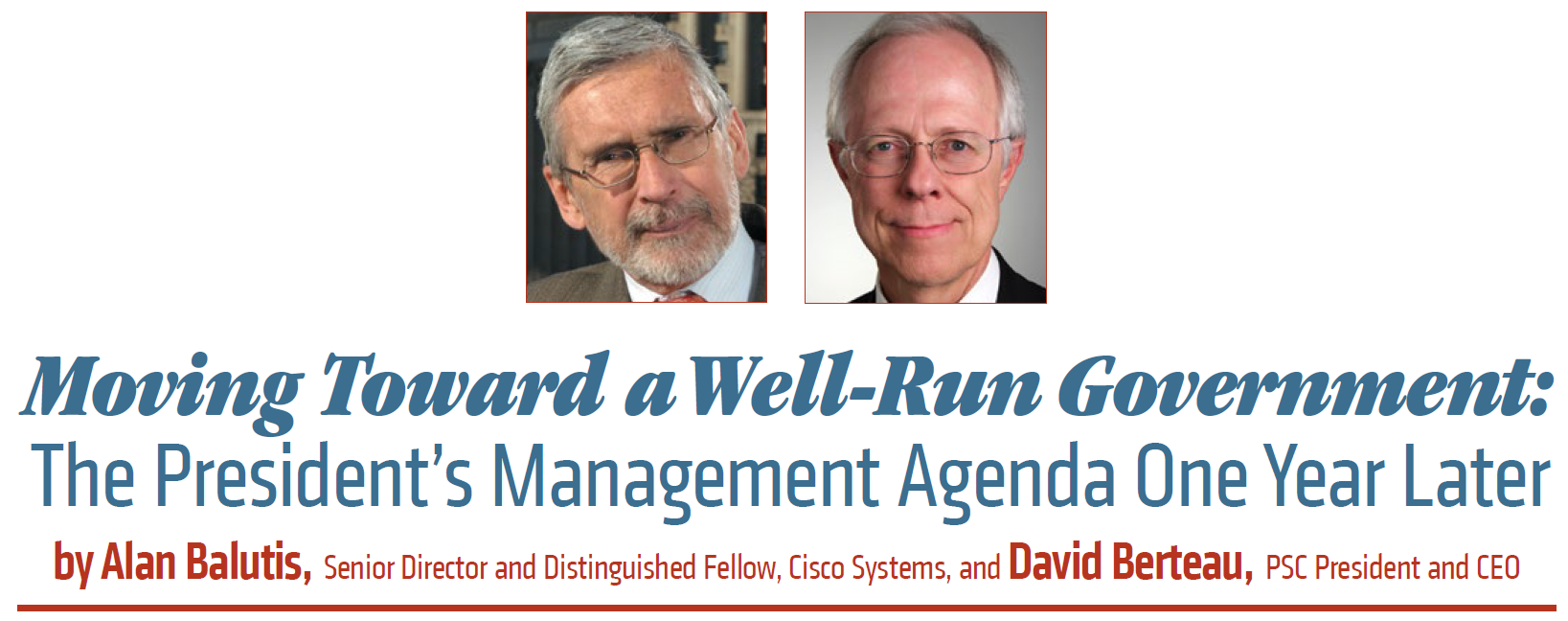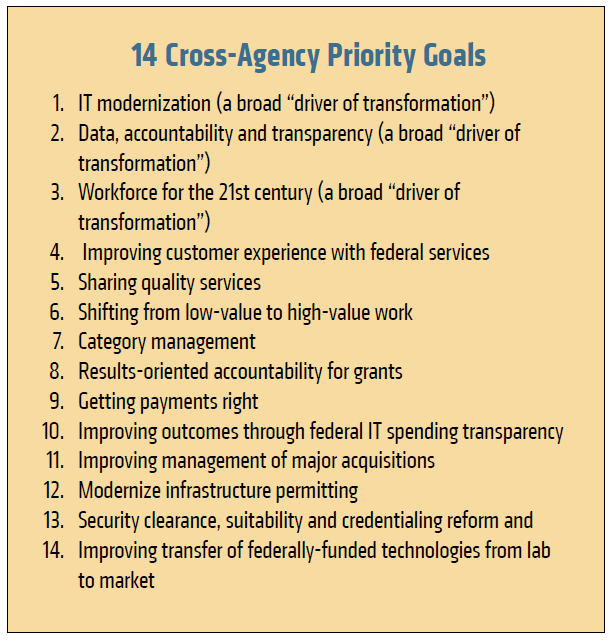
Every President–for decades–has organized an effort to reform government. These undertakings have often carried different names. For many Administrations, such an effort needed the appearance of being fresh and new and full of ideas that no prior Presidency could possibly have created. For some, it takes years for the agenda to take shape and be issued. For others, the reform focus is at the agency level rather than centrally directed from the White House (we are thinking here of Secretary of Defense Robert McNamara’s Cost Reduction Program, which had no government-wide equivalent under President John Kennedy).
Some reform efforts struggled with identifying measurable goals, with creating benchmarks for those measures, and with public reporting of progress from the benchmarks to the goals. (NOTE: In one Administration, when faced with negative progress toward a specific White House goal, a senior official remarked “we need new metrics”).
This Administration certainly has no shortage of problems to solve. The question is whether it can adopt new approaches to the management of government to meet the challenges it faces. Facing these challenges will require a “changed”

government. By that we don’t mean a clichéd bumper sticker government – one that “does more with less” or is “leaner and more efficient.” We mean a 21st century government transformed to operate on demand.
Both of us have many years in and around our federal government. In the late 1960’s and early 70’s, agencies were still struggling with Lyndon Johnson’s Planning, Programming and Budgeting System and Richard Nixon’s Management by Objectives. Jimmy Carter had Zero-Base Budgeting. Ronald Reagan kicked off Reform ‘88 and committed to privatizing the government under a roadmap laid out in the 29 volumes of the Grace Commission. Bush 41 continued those efforts, burnished by “a thousand points of light.” The Clinton Administration had “Reinventing Government”. Bush 43 gave a speech in July 2000, focused on “citizen-centered, results-oriented and, wherever possible, market-based” government (he later was the first to use the phrase “president’s management agenda”). In 2009, President Obama rolled out his plan to make government more transparent and to appoint a Chief Performance Officer and a Chief Technology Officer.
Now we have President Trump’s management agenda (the President’s Management Agenda, or PMA). One will note similarities with previous agendas. That can be reassuring, because bringing about change in a Fortune One company like our Federal government takes time, leadership commitment, and continuity. With the economy improving and the potential for bipartisan government reform, the Administration can turn to information technology modernization, acquisition reform, personnel streamlining, and management improvement. These may sound boring to some, but you have to get them right to make government exciting, attractive and effective again. As the Washington Post’s E.J. Dionne, Jr. observed in a recent column:
The greatest obstacle . . . now is . . . the dismal view of government performance held by the vast majority of Americans. The antidote is a well-run government.
In that context, this PMA stands out in several ways that matter to Federal agencies and affect the market for government services and solutions contracts. Let’s quickly review some obvious strengths and weaknesses of the Trump plan and its implications for industry.
Strengths:
•
Created earlier in the four-year term than was true for some prior Administrations.
•
Did not reinvent initiatives, but instead many of the 14 cross-agency priority goals are the same or similar from previous Administrations. Built on and continued emphasis on prior work and progress.
•
Clear objectives, milestones, and reporting that is visible to the public.
•
Committed and publicly visible leadership from the Office of Management and Budget, the federal Chief Information Officer, the Administrator of the General Services Administration, and the leadership at the Office of Personnel Management.
•
A focus on the end goal – improved service to the citizen.
•
Information Technology not seen as a stovepipe, but as an enabler–a force-multiplier to achieve a number of PMA goals.
Weaknesses:
•
The resource commitment is less clear and visible. It’s hard to track in the FY2020 budget materials.
•
Many CAP goals remain too focused on inputs, not measurable results.
•
Challenge of continuity – how does this survive the transition from current leadership?
Of Particular Interest to Industry
CAP Goal 1, IT Modernization – Modernizing Government Technology (MGT) Act was enacted in December 2017 as part of FY2018 National Defense Authorization Act (NDAA), but the statute applies government-wide. However, only two Centers of Excellence have been created to date, and MGT authority expires in six months. In addition, the White House has struggled over funding and over creating agency-level Working Capital Funds to pay for IT modernization with savings from legacy systems reductions.
CAP Goal 7, Category Management – This goal can be too heavily focused on dollar savings and not on results or solutions.
Best-in-Class (BiC) contracts can (overnight and with no warning) cut off vendors from customers they’ve supported for years or longer.
CAP Goal 13, Security Clearances – Uncertainty remains over the still-pending transfer of all background investigations to the Department of Defense (from the administration’s June 21, 2018, reorganization proposals).
Conclusion
The PMA celebrated its first “birthday” or perhaps “anniversary” in March. As we have noted, there are many positive signs and foundational progress to point to. But this will be the key year to see what real accomplishments emerge. Watch closely with us as we track and report on what develops.
| __________________________________________________________ |
This article was published in the Spring 2019 Service Contractor. Click here to view a PDF of this article.